Belfast and Its Troubles: What a Black Taxi Tour in Belfast is Like
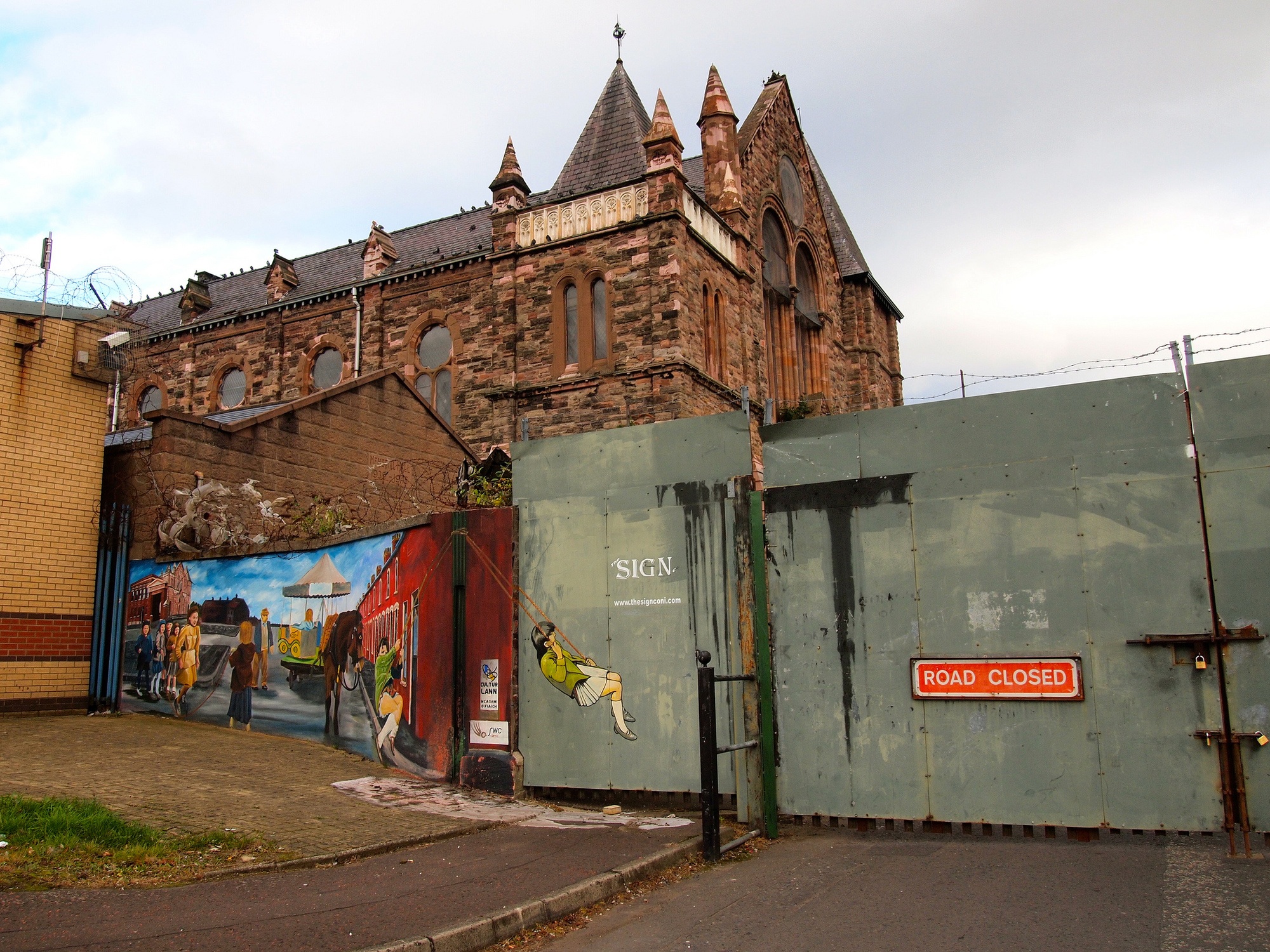
As I stand in front of the International Wall in Belfast, topped with barbed wire and splashed with political murals, I can't help feeling like I've seen it before. Like I've stood here before.
And yet, when I stood in front of the colorful murals at Berlin's East Side Gallery – painted on a still-standing section of the now-defunct Berlin Wall – I stood there with the knowledge that that part of Berlin's past was behind it. That part of the wall stands now only as a symbol; a reminder of how things used to be.
In Belfast, however? The walls and gates scattered throughout the city of Belfast are still there to serve a purpose.

A city of gates and detours
I walk up to a closed-up gate; it's a Saturday afternoon, and my Black Taxi driver/guide Brian explains to me that all the gates in the city close to traffic at nights and on weekends. Unlike in Berlin during the Cold War days, however, this doesn't mean that you can't cross from one side of the city to the “other.” It just simply means you have to make a detour; take a slightly longer route.
“It started when I was 9,” Brian says. He's referring to what the wider world would eventually come to refer to as “The Troubles” – politically-driven violence in Belfast that would stretch over a span of nearly 30 years and claim more than 3,600 lives.
“I thought it was normal,” he says. “When I started driving (a taxi), I would just go about my business. The walls? They were just an inconvenience. Only now, giving these tours, are we starting to realize that it's not normal.”
As I stare at a mural of a little girl sitting on a swing beneath barbed wire coated in years worth of plastic and paper debris, I have a hard time fathoming that this could ever feel “normal.”
“The Troubles” in Belfast
Most historians will tell you that The Troubles were not a religious conflict. They will say that it all began in the late 1960s with the Loyalists/Unionists arguing with the Republicans/Nationalists about whether or not the counties that make up Northern Ireland should stay a part of the United Kingdom, or join the free state of the Republic of Ireland.
And it's true that a big part of the conflict was based around a question of national identity. But tied to this national identity was the matter of religion – most of the Loyalists were Protestant, and most of the Republicans Catholic.
From the 1920s right on through the 1960s, Catholics in Northern Ireland were essentially treated as second-class citizens. They were not allowed to vote, and could only hold menial jobs no matter how great their skills/knowledge were. In 1964, a (peaceful) civil rights movement was begun by the Nationalists seeking to put an end to the discrimination of Catholics in Northern Ireland.
It only took a few years, however, for things to turn violent.
By August of 1969, riots were breaking out across the country, Loyalists and Republicans were clashing physically, Catholics were being burned out of their homes, and the British military was called in to put an end to it all.
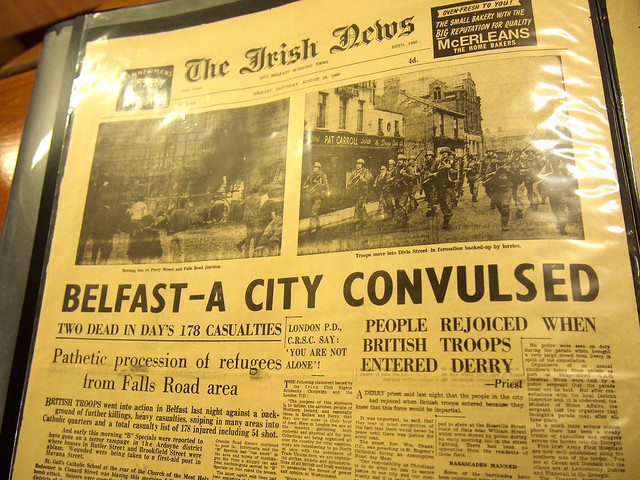
By the time 1970 rolled around, Belfast's now-iconic black cabs began operating due to the collapse of the city's public transportation. For decades, the cabs were just that: a means of transportation around a divided and warring city.
Today, however, the cab drivers also give historical tours around Belfast, sharing their memories of and insights about The Troubles.
Want to book one of these tours? You can book one here.
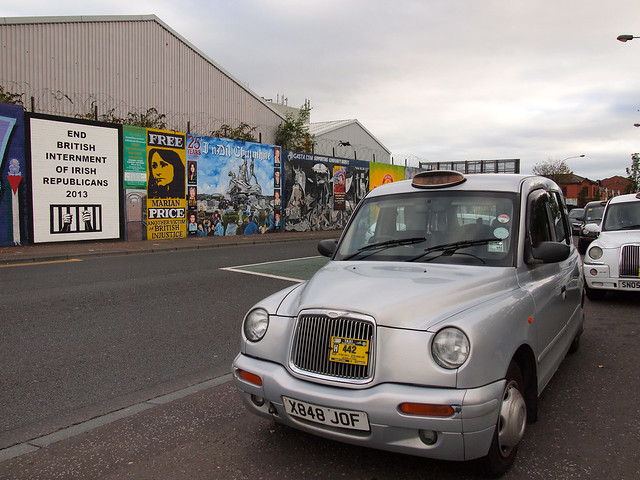
Belfast today
While a ceasefire was enacted in Belfast in 1994 and the Good Friday Agreement was signed by both sides in 1998, tensions still exist in the city. Between 50 and 80 walls, fences, and gates still remain in place, separating one “side” from the other. Some have been reinforced and made taller just in the past 20 years.
“There is a kind of peace now,” Brian says. “But not a solution. It's not over yet.“
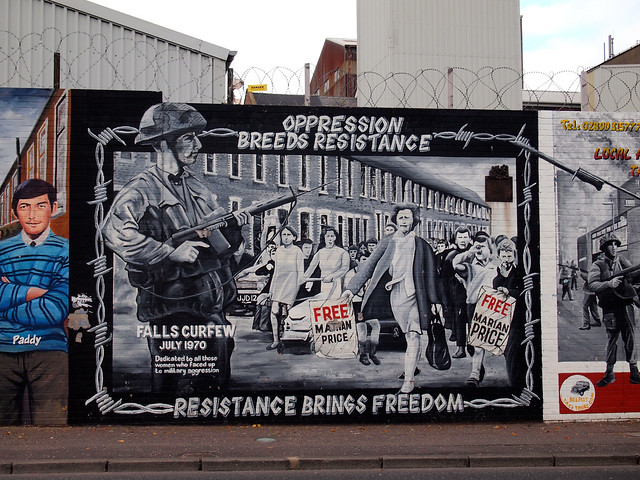
While Brian explains that most Catholics in Belfast feel that they are better off now than they were 20 years ago – there's now a shared government and religiously integrated schools, for example – The Troubles have by no means disappeared completely.
Homes near the walls still have to have metal grills or steel cages around their windows to guard against the rocks and bottles that are still frequently tossed over. Half of the city still displays the Union Jack, while the other flies the Irish tricolor flag. And, when new public housing is built in the city, Brian says it is still built with a separating wall.
Again: there may be a semblance of peace here now, but it's not over yet.
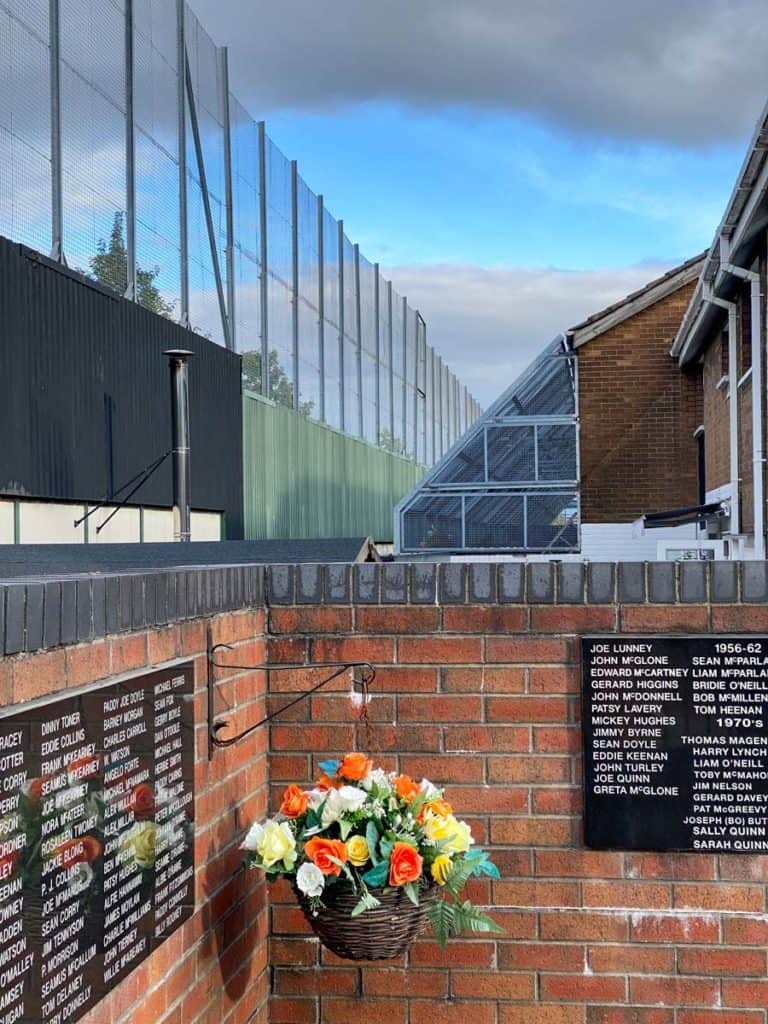
A black taxi tour of Belfast
You never quite know what to expect on a tour like this. And going on a black taxi tour in Belfast is unique because each tour will be slightly different based on your taxi driver. The drivers are all actual taxi drivers who grew up in Belfast, so their stories of The Troubles are obviously going to vary depending on which side of the wall they grew up on.
On my tour with Brian, we drive around the city for nearly two hours, stopping at a small museum, a church, and various large “memorial” murals dedicated to everyone from innocent victims to assassins-for-hire.
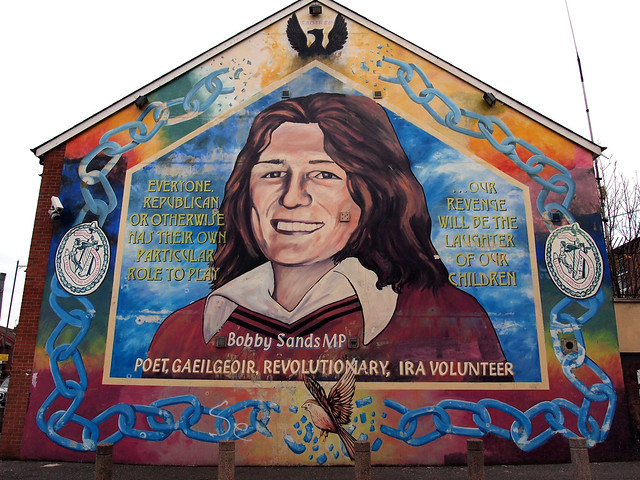
Brian tells my small group about all the paramilitary groups that were involved in the Troubles like the IRA (the Provisional Irish Republican Army), the UVF (Ulster Volunteer Force), and the UDA (Ulster Defence Association), among others. As an American, I've only really heard of the pro-Irish (and Catholic) IRA, but they were not the only ones involved.
We stop at the mural-covered International Wall, which has murals that call out injustices all around the world. We also stop at the Peace Wall, a taller wall covered in graffiti that separates the Catholic Falls Road from the Protestant Shankhill Road.
Again, I can't help being reminded of Berlin.
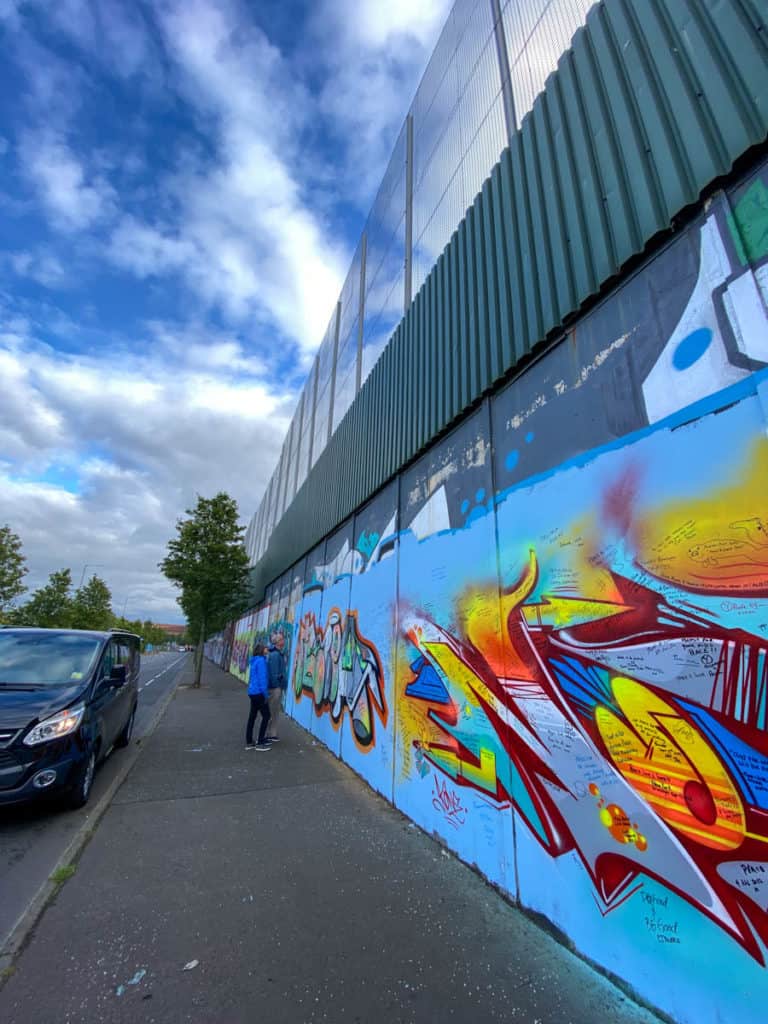
Just like in Berlin, I try to imagine what it must have been like (what it STILL must be like) to grow up in a city like this. A city divided. A city in which children are raised to view their neighbors – sometimes quite literally – as “the other.”
I ask Brian if he thinks the walls will ever come down.
“Oh yes,” he says. “But not in my lifetime.”
While the outright war has ended, most of the paramilitary groups still exist in some form in Belfast. Divisive and controversial Orange marches still happen each summer. There are still protests and the occasional violent attack or scuffle.
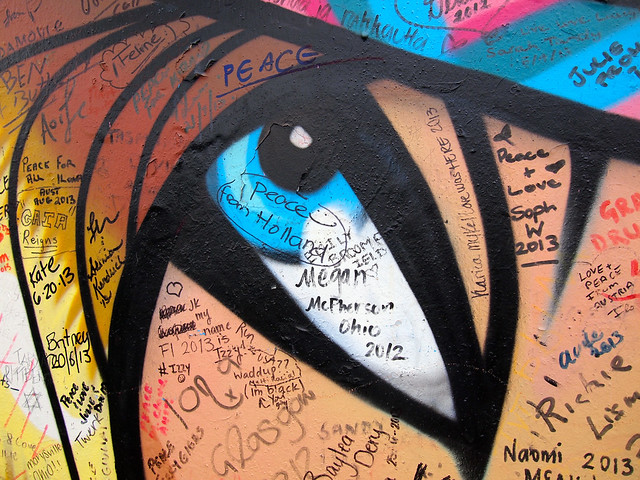
It's not all hopeless, however.
Brian tells me that the tensions ease up more and more with each passing year. He says that, in the south part of Belfast, the divisions have all but disappeared. And, he says, more people (and younger people especially) are beginning to accept each other regardless of which “side” they come from.
“I didn't have a Protestant friend until I went to the workplace,” Brian admits toward the end of our tour. “And it's still not something you talk about with your buddies; we talk about sport and our kids – never politics or religion. But I still remember that first time I met someone who wasn't Catholic. I remember looking for different eyes, different ears. Something, anything, that made us so… different.”
“But you know what? We look the same. We are the same.“
Hopefully someday soon the rest of Belfast can become as wise as Brian the Taxi Driver.
IF YOU GO
There are a LOT of Black Taxi companies offering tours around Belfast. They all are very similar, and they all utilize drivers who lived (and sometimes worked) through The Troubles. The tours offer informative, balanced tours of both “sides” of Belfast.
Some tour options to check out include:
- Private Black Taxi Tour
- Belfast Famous Black Taxi Tour
- Belfast Troubles Historical Walking Tour
- Belfast Mural Tour
- 90 Minute Belfast Black Taxi Tour
- 2-Hour Black Taxi and Mural Tour
- Northern Ireland Highlights Day Trip Including Giant's Causeway from Dublin
Is a political tour like this something you would ever do on your travels?
Pin it for later:
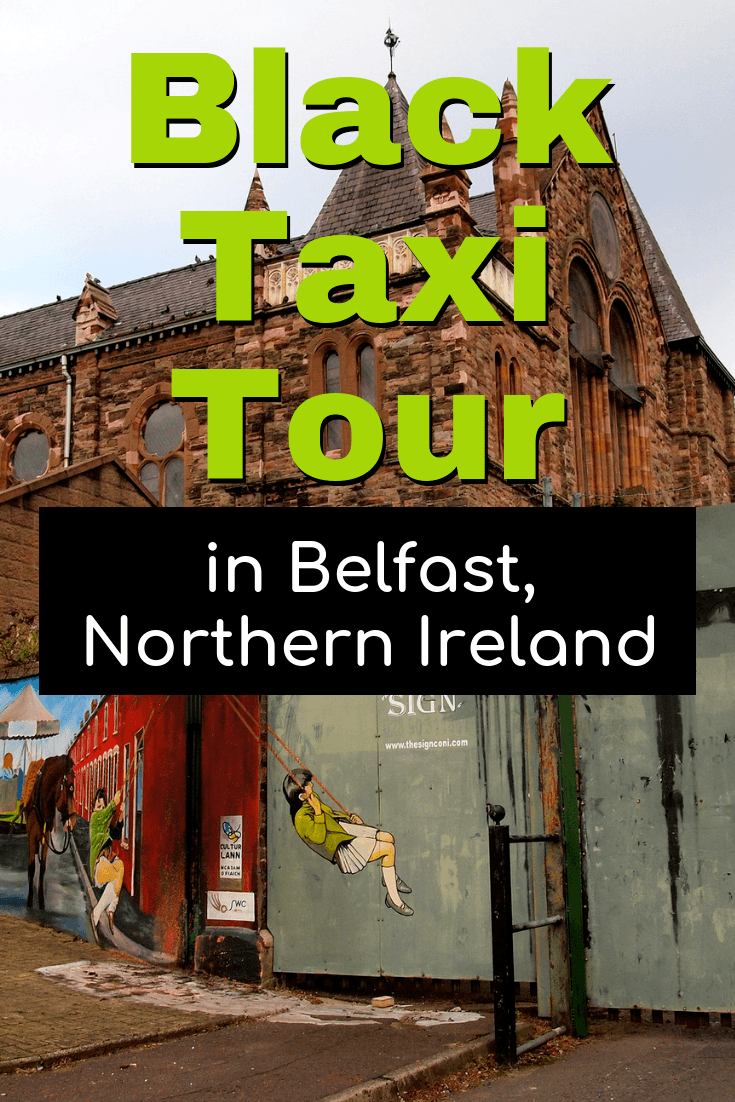

Amanda Williams is the award-winning blogger behind A Dangerous Business Travel Blog. She has traveled to more than 60 countries on 6 continents from her home base in Ohio, specializing in experiential and thoughtful travel through the US, Europe, and rest of the world. Amanda only shares tips based on her personal experiences and places she's actually traveled!

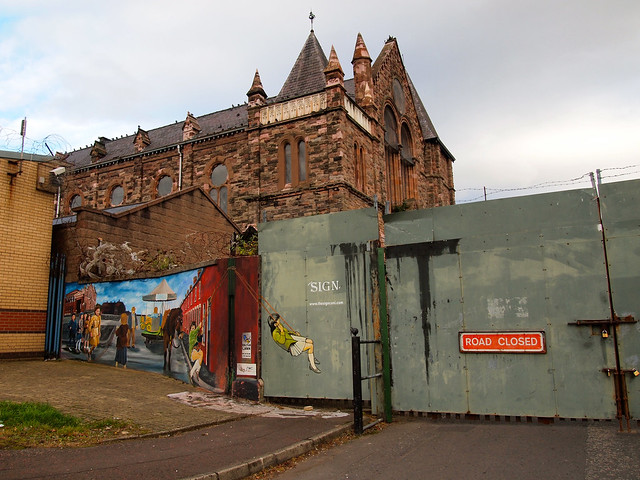
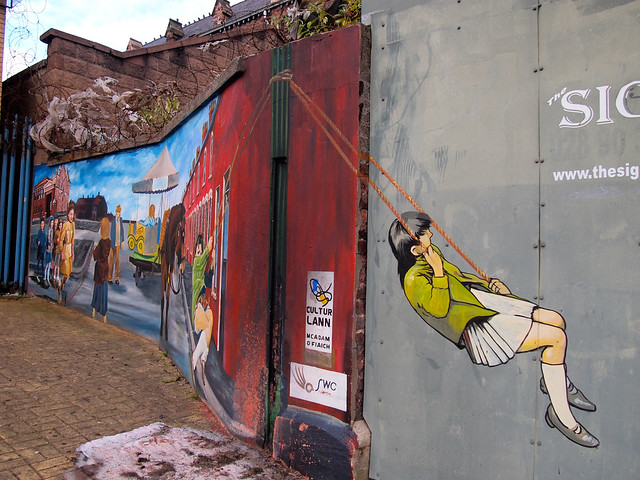









I stayed in County Down for two weeks in July 2017. I took a black taxi tour with Paddy’s Black Taxi Tours. Very neutral tour which presented both sides. I could not tell which side the driver was on although I know they are nearly all Catholic. I noted where we drove and the next day, I went back. I walked the streets to get the real feel without the driver present. I am 51 and my memories of the conflict in Belfast are vivid. The rumor is the wall is coming down soon. “We are sending it to America”, joked my driver. I seriously hope it stays in place. There is nothing settled in the city. Tensions are still high. I read here Brian said there are integrated schools? Not so. There is still segregation in the inner city. The murals, memorials, and relatives keep the feelings of injustice alive and raw. Until people can begin letting go of their pain the city needs its walls. It’s incredibly sad. Still, it is the #1 place in the UK I would move to if given the opportunity. They need people. Just don’t live in the inner city. (The Highlands are so close!)
There are some integrated schools – but you’re right that not all of them are. I certainly hope the wall can come down in my lifetime, but on my most recent visit there, a guide was telling us that a university group did a survey of people who live right next to either side of the wall, and 68% of them say they feel safer with it and don’t want it taken down. So yes, they still have a long way to go!
I may travel to Belfast in early October this year. Aside from visiting the Titanic Museum and a trip to Giant’s Causeway, I want to sign up for a tour to understand about The Troubles. Am glad that I came across your post on twitter, gonna bookmark this for future reference later in the year. Thanks for sharing ?
A Black Cab tour of Belfast is definitely worth doing! Glad I could help you out!
Interesting view point and very informative. can I just say one thing as someone who was born in Northern Ireland that no one should be in the slightest bit put off traveling to N. Ireland today. In comparing the murder rate of Northern Ireland (population of 1.8m) against every city in the US that has a population over 250k, Northern Ireland would rank 72nd out of 74. You can find trouble if you look for it as in any city but the Irish are especially known for their friendliness and their irrepressable spirit. Also it has some of the best open countryside in the world. Just watch Game of Thrones to see some of the countryside.
I totally agree with you! Nobody should let this recent history keep them from going to Northern Ireland!
Taking a Black Taxi tour was definitely one of our highlights when we traveled to Belfast and Northern Ireland. The taxi drivers were so open. I agree, if you go to Belfast they are a must.
Yup, it’s definitely a must-do. I learned so much.
Hi Amanda – didnt realise you were in Northern Ireland or I’d have given you a few tips. As someone who grew up in all this, it’s hard to take these “black taxi drivers” too seriously. This guy it seems (at least from your photos) only took you to the more Catholic and Republican areas. Is this right? The Protestant parts have a load of cool murals with Princess Diana, the Queen, UVF and even Northern Irish football heroes like George Best (whom we also named one of the airports after). I’m slightly biased though, being a unionist 😉 My birthtown of Newtownards is just down the road and has a really cool Tower to check out. I grew up in Bangor and Belfast and still enjoy going back. I hope you enjoyed it. It’s a great wee place and we need more tourists. Other top spots are Lough Neagh, Giants Causeway, Bushmills Distillery and the Mourne Mountains. Safe travels. Jonny
No worries – I only went up very briefly to see Belfast and visit the Giant’s Causeway since I found myself with some extra days in Dublin!
As for the tour, we did visit a lot of things on the Republican side of the walls, but we also went to the Protestant parts and saw some of those murals you mentioned (the tour I took actually focuses on the murals). Sadly, my camera decided to change settings on me, and none of the photos I took in that part of the city turned out!
I will say, though, that our driver presented what I felt was a nicely balanced picture of Belfast and The Troubles. He didn’t make any one side out to be “the bad guy.” It’s one of the reasons why I would recommend this tour – I learned a lot!
My mother cried when I told her I was going to Belfast. She thought I was in danger. I can honestly say that I never once felt that I was in danger while travelling in Northern Ireland. I learned so much about their history and I feel like I get it now. Being there made such a difference.
I agree – going there helped me understand it all a lot better. And Northern Ireland is GORGEOUS! I never felt in danger, either, and definitely would like to go back again sometime.
A lot of people here write that it is so strange to have walls inside a city to separate people but I saw a lot of walls too when I visited the US, Americans call it ‘gated communities’.
Hmm, I guess that is true. And those walls also serve as a form of segregation. But people live behind those sorts of “walls” by choice – not because of violence or political upheaval or because someone else is dividing them from others.
Makes you wonder what’s worse…
I highly doubt that people living in gated communities look at those walls negatively… And the people outside? Well I don’t think most of us really care one way or the other, to be honest. As far as national psyche goes, I would definitely say that walls like those in Northern Ireland are worse.
hahahhahahahaha its hardly the same thing is it
Such a tragic, but fascinating history. Thank you for sharing! Belfast and NI are high on my list to visit. I will most definitely be taking this tour when I make it there!
Thank YOU for reading! If you ever make it to Belfast, I highly recommend one of these tours. SO interesting.
Great post Amanda!
I’ve never been to Belfast but know all about the troubles, and can see why it can be so easily compared to Berlin.
While any conflict is bad, conflict over religion really infuriates and upsets me. Hopefully things will continue to improve in the future.
I totally agree, Kay – these sorts of conflicts just boggle me. I mean, I get that there’s more than just religion involved. But still…
Excellent post – I met a man last year who said he had started doing the tours. Could not believe the interest in them because like you say, they assumed it was normal.
Yeah! It’s really interesting how used to it the people living there have gotten to it.
I’ve certainly heard about the Troubles and Bobby Sands, etc. but I never realized that all these walls are still up and still being built to separate the city. It must have been such an interesting tour.
It was a fascinating tour. Made me want to go read more about what Belfast is like today.
I recently went to Belfast and did the tour with a bloke called Paddy (Not sure which company he is with, but he was full of knowledge!)
My favourite mural was the one of the women marching. I think our tour may have been a bit skewed towards the Nationalists (tour guide was Catholic) but it’s quite horrible to think that segregation like this still happens today.
Thankfully, Northern Ireland is on the mend, they’ve started mixed schools and toned down a bit on the violence. Hoping that the wall coming down is something that I will get to see.
I hope those walls come down in my lifetime, too. We shall see.
Thank you for this post. Northern Ireland is a part of the world I haven’t read in other travel blogs, so it’s more than welcome!
Same here, Stefania – that’s why I wanted to go and write about it!
We met a local when in Belfast that said he has never traveled to the Western side of Belfast. A few weeks before we arrived, there was a riot with the sides fighting (it was this year). I can’t imagine living in a divided city either. Hoping it gets better.
It’s so crazy to realize that it’s still ongoing, isn’t it? I mean, yes, things have gotten better. But it’s far from “over.” I cannot fathom what it would be like to live there. But I certainly would go back again to try to learn more.
Excellent post! It’s such a tragic yet at the same time still fascinating topic. I first learned about these tours when Anthony Bourdain visited NI. It’s definitely something I’d like to do.
I would definitely recommend it! I was interested in Belfast to begin with, but a tour like this really helped me understand it (and even want to learn more).